Every company is searching for the optimal formula for successful product development. A great idea is not enough: it is just the beginning when you figure out the product’s features and market fit. The main development process can stretch for a long time, and the initial idea can be changed under the influence of various factors.
The product manager works with the product’s idea at all development stages, and his or her main task is to ensure a common vision of the product for every team member. To achieve this goal, the product manager can use a product roadmap, a strategically important document.
Let’s consider the product roadmap role in software development, its kinds and characteristics. Also, we’ll take a deeper look at how the product manager can synchronize developers’ work with the help of the product roadmap.
Product manager in short words
Let’s see the main product managers’ duties to understand what else they should do except creating the roadmap:
- to analyze market and competitors;
- to communicate with customers;
- to build a product vision;
- to create a development strategy;
- to estimate and prioritize tasks;
- to share product roadmaps with company’s departments;
- to maintain the product roadmap.
Both the product manager and product owner deal with the product; yet, their roles are different.
The area of responsibility of the product owner is the product value, backlog, user stories, technical and business requirements. But the critical difference is that there is no product owner’s role in scrum projects.
What is included in the product roadmap?
The product roadmap is the result of strategic planning and describes common stages of product development. It should be a link between the vision of the product and the business goals of the product. Generally, the product roadmap consists of several parts of executive strategy:
Product vision: your perception of the future product.
Strategy: a detailed description of what the company should do to achieve the goals and meet the product vision.
Goal: a particular and time-limited task that you can measure with certain metrics.
Initiative: a broad term that covers features you should implement to achieve the goal.
Feature: a part of the product functionality or third-party application.
Time-frames: periods of time needed to achieve the goal or implement the feature. The product roadmap, as a rule, assumes only approximation in timing.
Status markers: they are used for tracking how the working process goes.
Metrics: helpful KPIs that you can use for measuring data important for product development, for example, organic traffic or churn rate.
The kind of product influences the choice of metrics and roadmapping participants. As a rule, those can be developers, support, operational, QA team, UX, sales department, marketing, and designers — everyone who will work on the product.
The product roadmap should be clear and easy to understand. Let’s consider what other requirements the product roadmap should meet:
- to map the strategy of product development;
- to present product vision;
- to evaluate with requirements of the marketplace;
- to prioritize crucial moments in the process of development;
- to provide communication between all involved specialists;
- to set long-term timings;
- to link exact tasks and business goals.
Also, there can be situations when the product manager should create several types of product roadmaps with information for internal and external stakeholders.
Stages of product roadmap development
Creating a product roadmap consists of several stages and requires certain preparation. So, let’s consider important moments step by step.
#1. Formulate your strategy and product vision
At this stage, you should analyze the market and competitors, interview your customers, discuss the product with stakeholders, and align it with management. These actions will give you all the needed information for creating the product roadmap.
#2. Define your audience
The audience is a key factor that implies your product roadmap format, its type, and type of content. So, you should focus on people who will work with this roadmap to create an appropriate one.
#3. Choose the format of roadmap
You should choose the most suitable format for the product roadmap based on your audience. For example, if you are choosing a feature-based format, it will complicate the work of marketing and management teams. So, such a format of a product roadmap is required for the developers’ team.
The chosen format allows you to prioritize particular tasks and goals on your timeline and provides the needed parts of data that you should highlight.
#4. Choose metrics and link them with real features
Metrics are used to measure the progress of your product development. So, you should choose KPIs according to your product roadmap goals: they can be oriented on customer or business goals. If you need relevant information, you can analyze the market and competitors or turn to the industry analyst.
#5. Use product roadmap tools
The usage of special tools can simplify creating the roadmap. While, if you work with Excel, you will get a static presentation that is hard to update. So, cloud roadmap tools make creating and updating simpler and faster.
There are several examples of roadmap tools that you can use:
- Hygger. A convenient and user-friendly tool for product management and smart roadmapping. With the help of Hygger, you can create different kinds of roadmaps (for example, a product development, a product launch, or a marketing plan roadmap), and define your strategy, plan releases and deliver projects on time. American Bancorp, Harvard University, BASF, and Unilever chose Hygger for their needs.
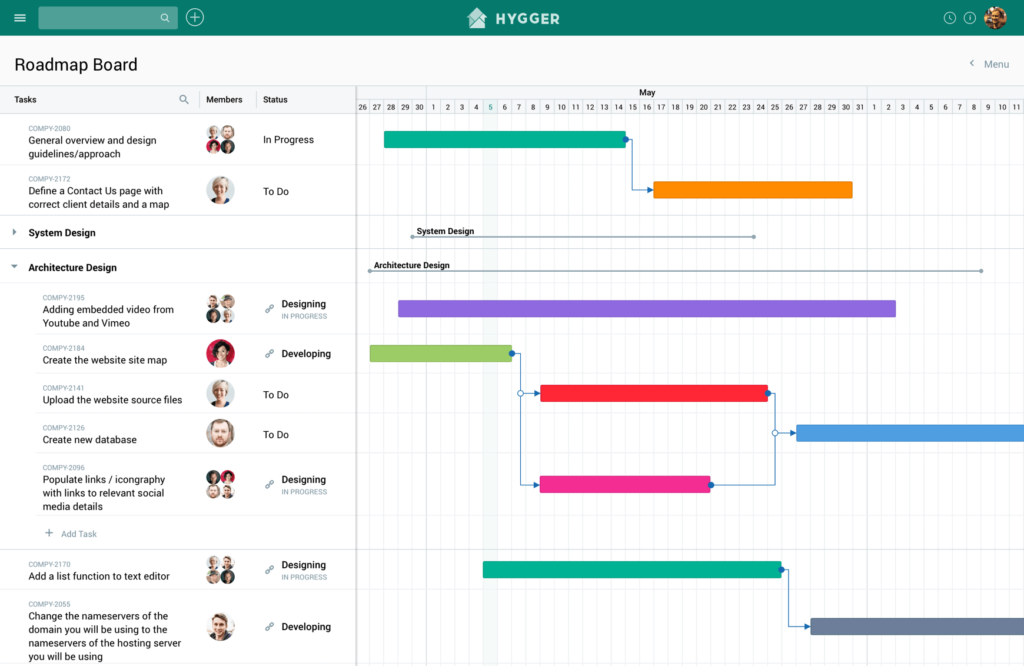
Source: Hygger.io
- OpenProject. Free-to-use roadmap instrument that allows product managers to create an unlimited number of projects under one account. OpenProject software is used for managing open-source projects and suits the requirements of Agile and Scrum teams.
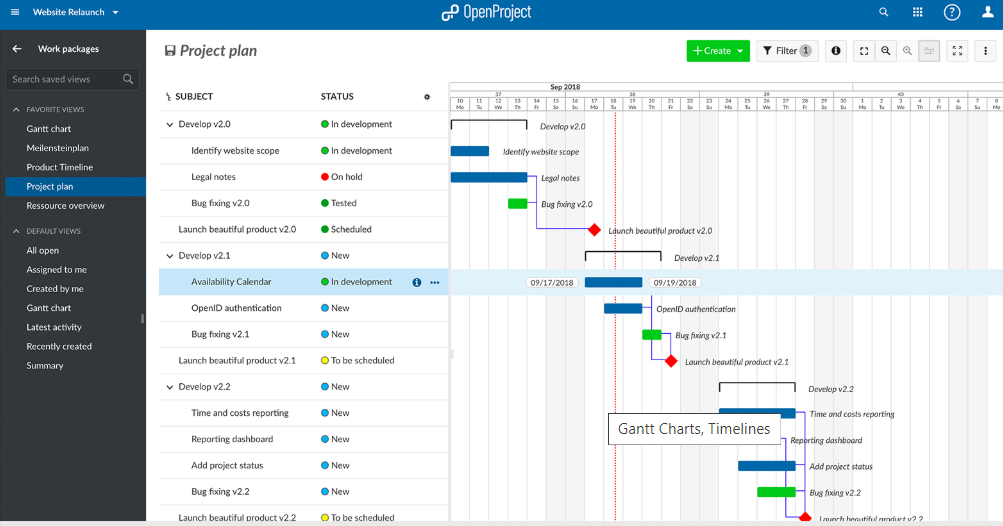
Source: openproject.org
- Roadmap planner. It is used for managing open-source products for Linux.
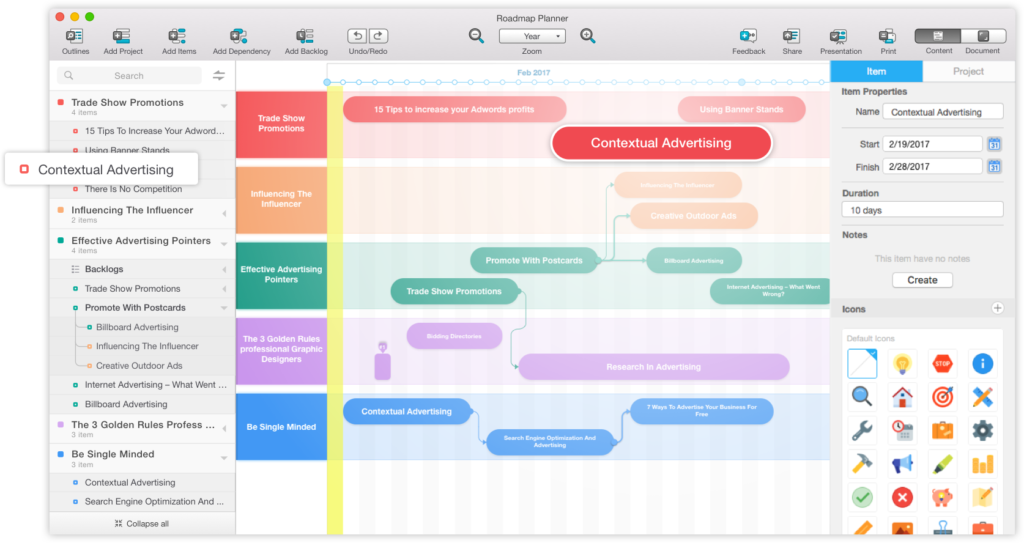
Source:roadmap-planner.io
- ProductPlan. It provides a lot of roadmap templates for different goals and gives the ability to import information from Jira, Spreadsheets, and VSTS. So, it is no wonder that Windows, Adobe, or HubSpot use ProductPlan for their goals.
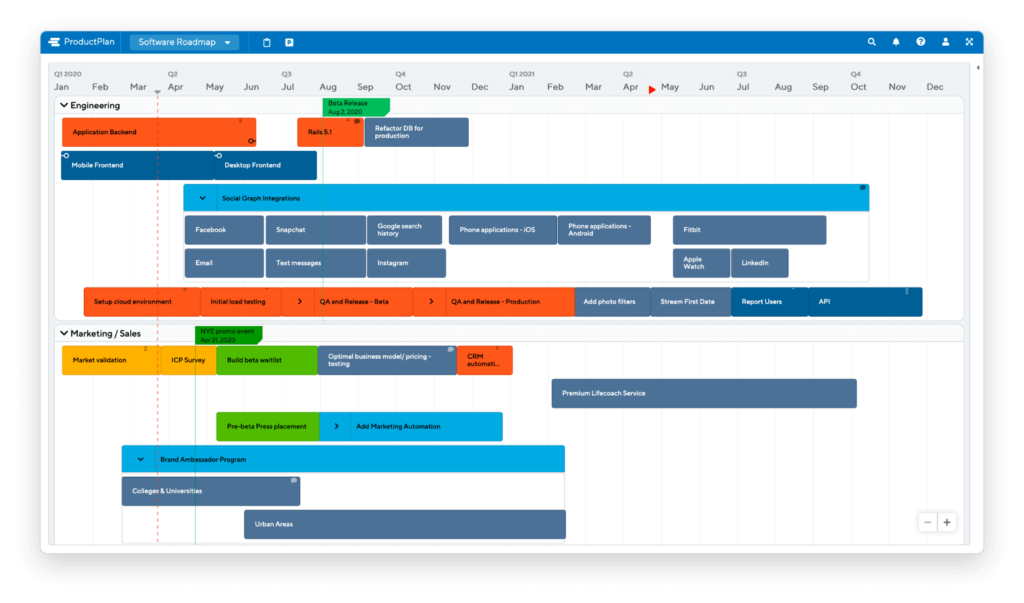
Source: productplan.com
- Aha! Another huge instrument for roadmap management that can integrate with a great number of applications. Shutterstock, Dell, Linkedln, and other large enterprises use Aha! in their work.
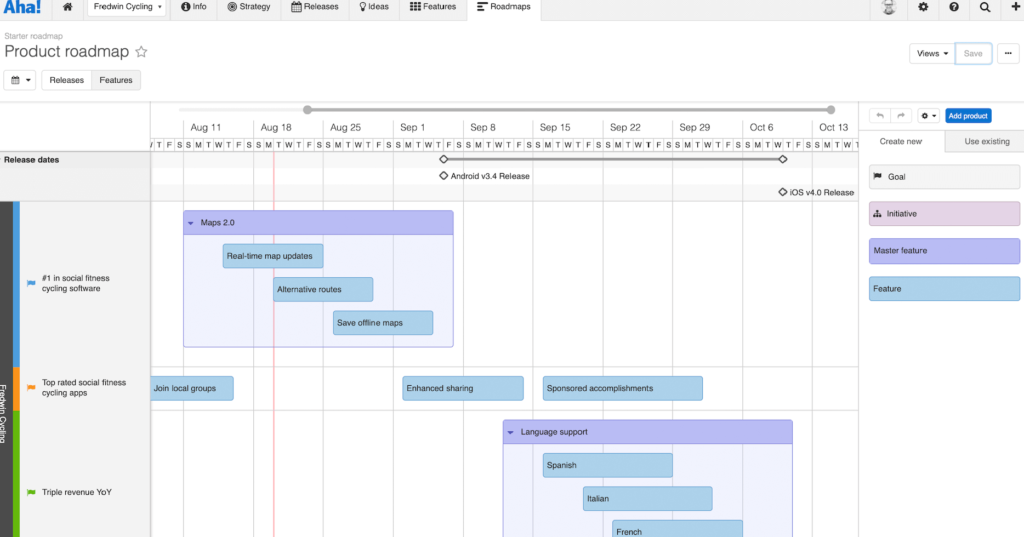
Source: aha.io
- Roadmunk. This tool also meets all accepted standards in roadmap management and provides affordable pricing. You can download and use helpful templates of these tools when you need to create the product roadmap, so it will simplify your working process.
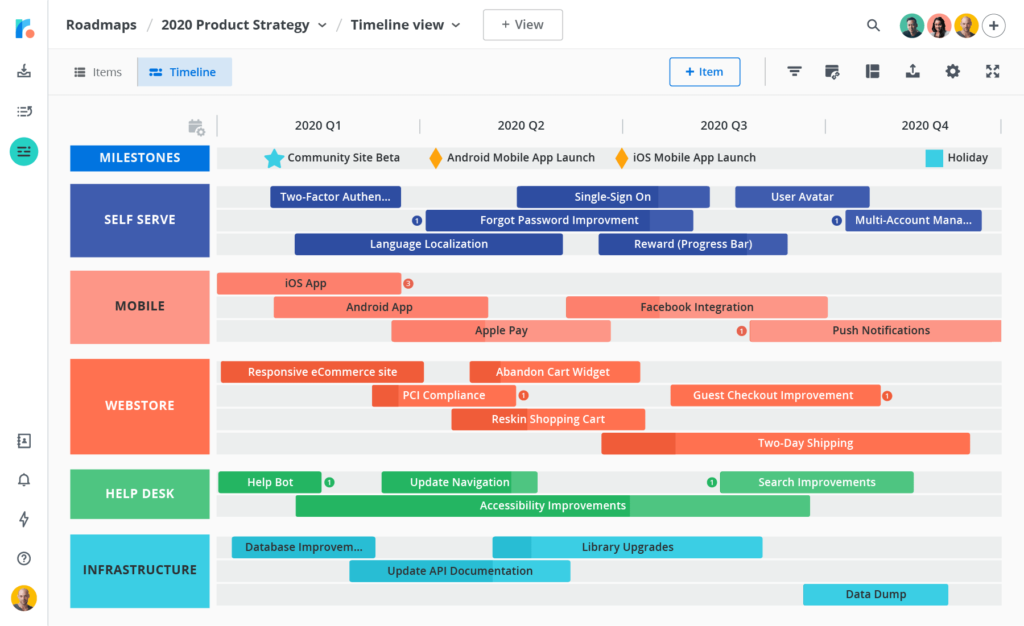
Source:roadmunk.com
#6. Avoid excessive information
You should maintain the relevance of roadmap information and avoid excessive detalization. Remember that the roadmap is about providing a common vision and strategy, not a tactic. This document should be clear and easy to understand. Too many details can mislead those who work with this roadmap.
#7. Keep the roadmap up to date
Your roadmap should represent the progress of your product, new abilities, and goals. So, add to the roadmap actual information, and new data for all who work with the roadmap.
Types of product roadmap audience
The product manager can demonstrate the roadmap to different people that are connected with the product. In this case, different information and level of the digitalization can be required. So, according to this, the product manager should create several roadmaps for different groups of stakeholders or one strategic document for all persons.
Let’s consider what types of audience need the roadmap.
Generally, there are two kinds of audiences: internal (your team and executives) and external (customers and investors).
Internal audience
Internal roadmaps are used for the work of a company’s departments, so you should provide needed information for every related to the product group: executives, production team and sales department.
- The executive group requires strategic data. So, a roadmap for them should include the common vision, strategic goals, timings, information about markets, etc.
- The production team is focused on the tactical side, technical details, and deadlines. So, the roadmap for the production group should be related to particular product parts, features, or themes. It is a low-level kind of information.
- The sales department is interested in the product’s features, pricing, and its advantages for customers. In this case, the product manager can use a theme-based format to show what feature is related to what objective.
External audience
External-oriented roadmaps usually don’t show particular information about internal working processes and deadlines, so they can be in a presentation form. They should be visually easy to understand, provide approximate timings and succession of feature releases, demonstrate profit for customers.
Types of product roadmaps
There are several types of product roadmaps that can be used in various projects, provide different kinds of information, and illustrate different logic. So, these roadmaps demonstrate differences in their structure and appearance. Brian Lawley in his “Expert Product Development” book demonstrates detailed roadmaps’ classification; let’s consider it.
- Strategy and Market roadmap with high-level details and market state.
- Visionary roadmap shows the product vision.
- Technological roadmap provides low-level information for the production team.
- Technology across product roadmap is a combination of actual technologies and features that are planned for the product.
- Platform roadmap is oriented on multi-platform digital products.
- Internal and external product roadmap is used for different types of the audience.
Agile-oriented teams and companies that deal with digital technologies development use more diverse kinds of roadmaps. So, let’s take a deeper look at the most popular examples of the product roadmaps where the audience plays a major role.
- The now-next-later roadmap. This kind of roadmaps describes tasks, features, or sprints by their priority as in the product’s backlog that classifies information horizontally and vertically. It is about task prioritization in the simplest way. So, an audience can see the status of tasks in progress.
- A goal-oriented roadmap is needed when you should group and describe all information about the product. Such a roadmap provides clear and easy to understand vision and goals. Remember that goals should be formulated in simple words, for example: “to increase customer engagement”, “to speed up the logging process”.
- A theme-oriented roadmap is similar to a goal-oriented one, but themes can include several goals at the same time. Themes and goals are close concepts, and both answer the question “why”.
- A feature-based roadmap is the most detailed one that demonstrates both pros and cons. Product features are not a permanent thing, and they can vary according to customers’ needs and technological innovations. So, there are no high-level details and clear product vision in this roadmap. It brings difficulties in understanding for an audience and in maintenance for a product manager.
- A strategy roadmap can be used for both internal and external audiences. It includes common high-level information about the product and based on a specific aspect that depends on the goal.
- A technology roadmap (IT-roadmap): a low-level document that follows a strategy roadmap. It is needed for production teams to formulate technological requirements and allocate the related resources.
- Manufacturing roadmaps are used for the manufacturing of the physical product. They are needed for managing productions and setting actual release dates.
- A portfolio roadmap is needed in communication between the product manager and executives. It is especially important in companies with several products: executives require to see the progress of each product and how they achieve business goals.
- A release roadmap: it is one of the external documents that are presented to customers. It includes the main releases of features of applications for common usage. Such a roadmap doesn’t require a great number of technical or practical details.
- A market roadmap is needed in case the company plans the product launch on several marketplaces. With its help, the marketing department and internal stakeholders can create a marketing strategy for products. This is the most dynamic kind of roadmaps that mirrors fast changes in the marketplace: competitor’s actions and technical progress have an impact on the marketing strategy, so a product manager should immediately update the roadmap.
Documents that support the roadmap
A product roadmap includes key information needed for the team’s work. So, to avoid the excessive detalization in roadmap, a product manager also should create several documents with low-level details.
A product backlog is a Scrum artifact with a list of high-level requirements and features that are created by a product owner. Backlog includes user stories; it is a tactical to-do list needed for product development.
A release plan: it is a document with clear release dates. Its accuracy is the main difference between a release plan and a roadmap. A roadmap demonstrates a succession of the product’s releases, and a release plan, in its turn, shows strict data when this or that feature will be released. It also can be helpful when product managers need to compare development sprints with certain features or bug fixes.
Does your company really need a product roadmap?
Proper product roadmap with actual updates and clear information is the source of strategic data for your teams, it is a useful and convenient tool. You should understand that writing and maintenance of any kind of documentation require the time and effort of the product manager. While, if a product manager has to spend a lot of time gathering the needed data from all team members and stakeholders and updating several documents along with the roadmap, you can do without a roadmap in your company.
You also can use other methods for task prioritization and timings, for example, user story mapping or Agile backlog prioritization techniques.
What tool or method do you use in your company for task management and prioritization in the product development process?





